IBDP Online Test Series By iitianacademy
Comprehensive Test Preparatory package targeted towards IBDP
Question
Tobacco mosaic virus (TMV) was used as a vector in the development of a new process for Hepatitis B vaccine production.
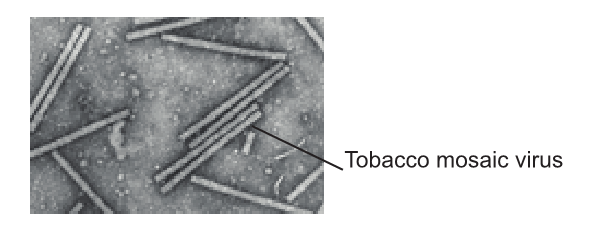
[Source: Scholthof, K-B.G. 2000. Tobacco mosaic virus. The Plant Health Instructor. DOI: 10.1094/PHI-I-2000-1010-01. Updated 2005. © 2018 The American Phytopathological Society. All rights reserved.]
State the role of a vector in biotechnology.
Explain how the Hepatitis B vaccine is produced using TMV.
State the importance of marker genes in genetic modification.
Answer/Explanation
Markscheme
carries/transfers genetic material into a cell
a. TMV contains RNA/is a retrovirus
b. gene of hepatitis B «virus» codes for antigen
OR
hepatitis B «virus» has a gene that induces an immune response
c. «antigen» fuses to capsid gene for TMV
d. two fused genes enter/infect the plant cells «using the virus as a vector»
e. mice fed with infected plants produce antibodies against hepatitis B
f. antibodies are extracted from mouse serum/blood
Allow other mammal
[Max 3 Marks]
marker genes show the «target» gene has been inserted
Question
Golden rice is a genetically modified variety of rice (Oryza sativa). The golden colour comes from beta-carotene, a precursor of vitamin A, in the edible parts of rice. The modification was achieved by the addition of two beta-carotene biosynthesis genes, one from a flower (Narcissus pseudonarcissus) and the other from a soil bacterium (Erwinia uredovora).
Using this information, outline the reason for Golden rice being considered a transgenic organism.
Outline the bioinformatics method used to identify the target gene in the plant.
Answer/Explanation
Markscheme
a. transgenic organisms produce proteins that were not previously part of their species’ proteome
b. golden rice has genes belonging to other species «flower and bacterium» that were not there naturally/originally
database/NCBI/BLAST/BLASTn/BLASTp search «to find target gene»
Question
Starch from different sources contains differing proportions of amylose and amylopectin. Potatoes (Solanum tuberosum) have been genetically modified to produce high-amylopectin starch (Amflora potatoes). Heat induces starch to form a gel in excess water. The graph shows gel formation temperature at different amylose concentrations.
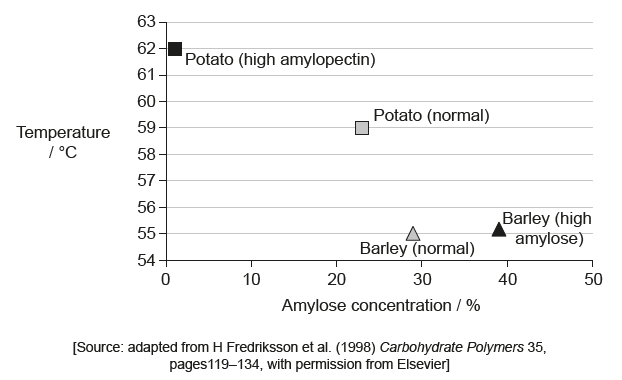
Discuss the hypothesis that the temperature at which starches form a gel depends on the degree of cross-linking of amylopectin.
State one advantage of potatoes with a high amylopectin content.
The Amflora potato was approved for industrial applications in the European Union (EU) in 2010 and was withdrawn in January 2012 due to opposition. Discuss reasons for people supporting or opposing the introduction of the Amflora potato in the EU.
Answer/Explanation
Markscheme
a. high amylopectin potatoes/low amylose need more heat to form gel «so hypothesis supported» ✓
b. «normal» potato and normal barley have similar amylose concentration but different gel formation temperatures «so hypothesis not supported» ✓
c. normal barley and high amylose barley have same gel formation temperature «so hypothesis not supported»
a. «high amylopectin potato starch is» used in paper production because it forms a clearer film «when forming a gel»
b. «high amylopectin potato starch is» used in adhesive production as it forms a stickier paste
c. «high amylopectin potato starch is» used in paper/adhesive production because there is less thickening of starch film/paste during storage compared to regular potato starch
supporting:
a. potatoes cheap to grow
b. benefits farmers/local producers «so less pollution»
c. reduces costs in «paper» industry eg: paper or adhesives
d. beneficial uses in industry
opposing:
e. perceived health risks/allergens
f. may cross pollinate with existing species
g. could be eaten accidentally
Question
Usually the size of particles used in biolistics with plant cells is 1000 nm. Researchers tested the effect of using smaller sized particles (40 nm) in the biolistic treatment of animal cells.
The degree of transfection by DNA and the damage to embryonic kidney cells was assessed using particles of the two different sizes. The amount of DNA attached to each particle, whether large or small, was the same.
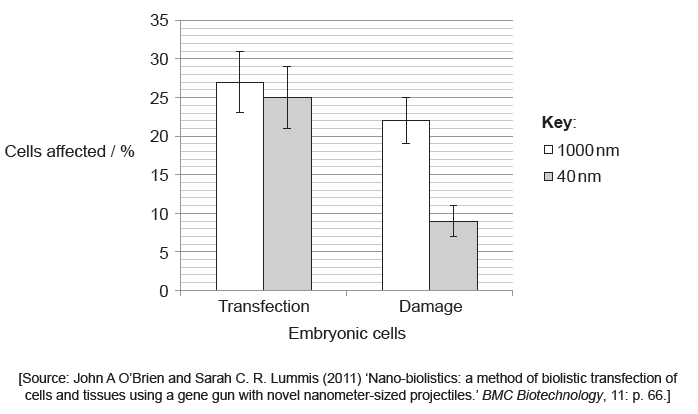
Describe the effect of the different sized particles on the treatment of these animal cells.
State one other physical method used to introduce DNA into plants.
Answer/Explanation
Markscheme
a. there is little/no significant difference in the success of transfecting DNA
b. there is «significantly» less damage to the cells with the smaller/40nm particles
electroporation / microinjection
Question
Freshwater invertebrates were sampled by students at three sites along a river in central France. The animals were identified and counted. The diversity of each site can be compared using Simpson’s reciprocal index.
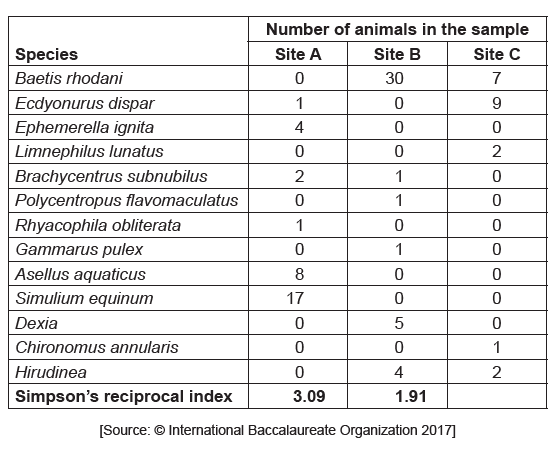
Simpson’s reciprocal index is given by the following formula:

Calculate the diversity of site C. Working should be shown.
Site A has a higher Simpson’s reciprocal index than Site B showing that its diversity is higher.
Explain the reason that ecologists consider Site A to have a higher diversity than Site B, despite both sites having six different species present.
Discuss the advantages and disadvantages of in situ conservation methods.
Answer/Explanation
Markscheme
a. ![]()
b. = 3.56 «allow 3.55»
a. the species in Site A are more evenly represented than site B
b. site B has a large number of one species «but very few in the other 5»
c. Simpson’s reciprocal index is a measure of species evenness as well as species richness
Advantages:
a. conservation in the natural habitat / ecosystem
b. the species will have all the resources that it is adapted to
c. the species will continue to evolve in their environment / can maintain genetic diversity
d. the species have more space so a bigger breeding populations can be kept
e. it is cheaper to keep an organism in its natural habitat
f. established food webs/ species interactions can be maintained
Disadvantages:
g. it is difficult to control illegal exploitation «eg poaching»/harder to monitor populations
h. the area may need restoring / may be required for other purposes
i. alien species are difficult to control
j. species close to extinction are harder to conserve
k. management/protection may represent a significant cost
Question
Discuss the environmental risks of the cultivation of genetically modified crops.
Answer/Explanation
Markscheme
a. antibiotic resistance «from marker genes» in the crops could be transferred to bacteria
b. but this has never been demonstrated
c. the precautionary principle should be applied
d. genetically modified crops could hybridise with wild plants/other crops
e. escape «of GM crop» could lead to outcompeting endemic species/wild plants / becoming invasive/superweed
f. herbicide resistance could develop in wild plants
OR
pesticide resistance could develop in pests
g. modifications can affect pollinating insects
h. example of genetically modified crop
eg Amflora potato / Bt maize
Question
One method of inserting new genes into plants is by gene gun.
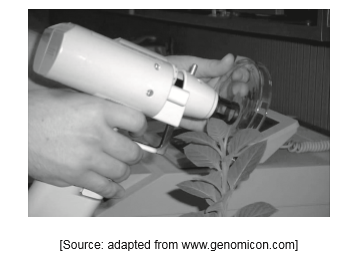
Outline how a gene gun inserts genes into plants.
Marker genes are often inserted together with the new gene. State the function of the marker genes.
Outline the characteristics of an open reading frame.
Explain, using an example, how gene transfer to a plant could help increase crop yield.
Answer/Explanation
Markscheme
a. metal/tungsten/gold/bullet is coated with DNA/gene
Biolistics on its own not accepted.
b. «this DNA is» fired in to a leaf containing the target cells
Accept any plant part, plant suspension, etc.
c. DNA is released and incorporated in to some of the cells
marker genes can be detected easily and show the gene has been inserted
Allow a specific example (eg, green fluorescent protein).
a. a length of DNA that codes for a polypeptide/protein
OR
length of DNA that can be translated
b. begins with start codon/TAC/ATG/DNA for methionine
c. stop codon occurs after sufficient length OWTTE.
a. name of GM plant eg: Soybean.
b. source of the inserted gene eg: (Cry1Ac gene) from Bacillus thuringiensis.
OR
organism used for transfer eg: plasmid from Agrobacterium tumefaciens.
c. purpose of the transfer eg: increased resistance to glyphosate herbicide.
d. how it increases yield eg: reduced competition with weeds killed by glyphosate.
Question
Before planting their crops, farmers have traditionally plowed their land to suppress weed growth. Unfortunately, plowing causes the loss of valuable topsoil. Modern farming is shifting toward the use of chemical weed killers such as glyphosate in combination with genetically modified glyphosate-tolerant (GT) crops. The graph shows the area of plowed land in the USA for soybeans in 1996 and 2001. During that period GT soybean planting increased from a few percent to about 70 %.
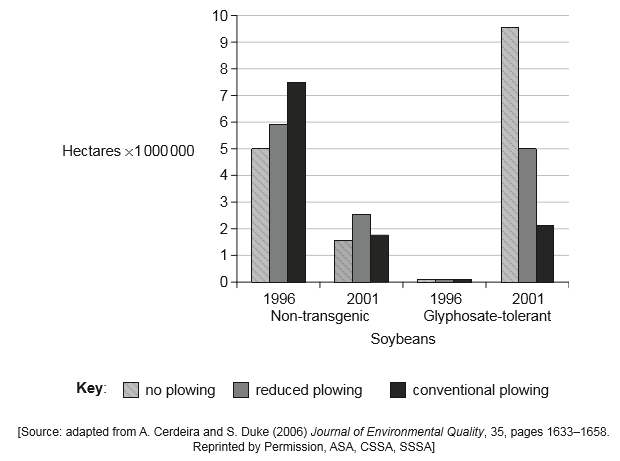
Evaluate the hypothesis that increased planting of glyphosate-tolerant crops has resulted in the reduction of plowing.
Explain the role of bioinformatics in the determination of the function of an unknown target gene.
Outline what is meant by open reading frame (ORF).
Genetic engineers sometimes use physical methods to transform cells. Describe the method of biolistics.
Answer/Explanation
Markscheme
«The hypothesis is supported as» less total land is plowed in 2001
«The hypothesis is supported as» the amount of land used for conventional plowing is less in 2001
«The hypothesis is supported as» the amount of land used for reduced plowing has increased in 2001
There is a negative correlation between increased GT soybean planted and area of land plowed
Involves database search for DNA sequence similar to unknown gene
Function of similar sequence used to infer the function of the unknown target gene
Use of nucleotide blast/BLASTn
Continuous/unbroken stretch of DNA between start codon and stop codon
Biolistics uses a gun device
Fires particles coated with DNA/gene
At plant tissue
Question
State the role of Rhizobium, Nitrobacter and Azotobacter in the nitrogen cycle.
Rhizobium: ……………………………………………………………
Nitrobacter: ……………………………………………………………
Azotobacter: ……………………………………………………………
Explain the production of methane from biomass.
Answer/Explanation
Markscheme
a. Rhizobium: nitrogen fixation;
b. Nitrobacter: oxidizes/changes nitrites to nitrates;
c. Azotobacter: nitrification / bind atmospheric nitrogen / nitrogen fixation;
a. anaerobic digestion of biodegradable material;
b. fermentation (of carbohydrates) by bacteria;
c. methanogens produce methane;
d. methane/biogas used as energy;
e. waste products used as fertilizer;
f. CO2 produced (as a by-product);
Question
The electron micrograph below shows a pathogen.
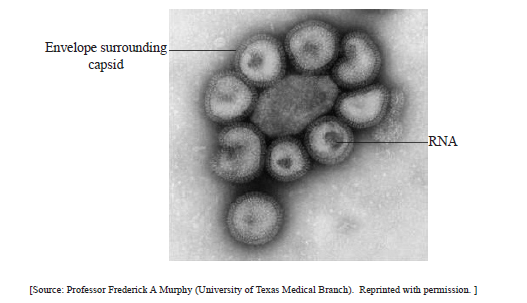
Identify the type of pathogen shown in the electron micrograph, giving reasons for your answer.
Outline the use of viral vectors in gene therapy.
Answer/Explanation
Markscheme
virus;
protein coat;
RNA/riboprotein;
removal of white blood cells / bone marrow cells;
using a vector; insert gene into chromosome;
cells are replaced in the body of the patient;
the normal gene can be expressed;
e.g. SCID where the replaced gene allows for the production of ADA/Adenosine deaminase;
